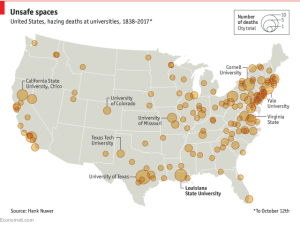Phoebe Barr ‘19:
College student deaths have made headlines in Philadelphia in the past six months. Cariann Hithon, Richard Dalcourt, and Jenna Burleigh all attended Temple University; Henry Rogers, Brett Cooper, and Nicholas Moya were students of the University of Pennsylvania. The causes of their deaths were varied; however, people throughout the community are reacting to the tragedies, and Penn and Temple are taking measures to see how they can comfort those affected.

Photo Courtesy of The Economist
According to various news sources, Cariann Hithon was 22 years old; she was in Florida on Sunday, October 8th, when she was shot by police. At the scene of an accident, in what appeared to the police as an attempt to flee, her car hit an officer and she was shot through the window. The officer struck by her car was not killed, and the officer who fired was placed on administrative leave.
Richard Dalcourt, a 19-year-old mechanical-engineering student, committed suicide by jumping from the window of his dormitory, the 1940 Residence Hall, on Tuesday, October 4th. Penn student Moya, 21, also committed suicide off campus on August 31st.
A former Temple student Joshua Hupperterz, 29 has been charged with killing 22-year-old Jenna Burleigh at a bar on August 31st. Around 2 am that Thursday was the last time Burleigh was seen alive, near the Temple campus in North Philadelphia. Her father reported her missing later that day, and her body was found on the afternoon of September 2nd in Hupperterz’s grandmother’s house in Wayne County.
Rogers and Cooper’s deaths are pending review, but Rogers appears to have died of natural causes.
The Tuttleman Counseling Services at Temple has been working with students who knew those killed personally. To that end, a self-help center and walk-in clinic are available to students at all times, offering individual counseling and group sessions according to students’ needs. These are available for as long as students need them.
At Penn, promptly notifying undergraduate faculty when a member of the student body dies has been standardized. Previously the information was held by the school’s dean and giving it out to the general faculty was optional. The entire student body will also be informed, as the messages to undergraduates after Moya’s suicide were more sporadic.
Cheryl McLauchlan, math teacher and junior Form Dean, expressed her feelings on the tragedy of the situation, noting that while the deaths were varied in cause, “most college campus deaths… excluding suicide, are senseless deaths,” pointing out the connection between many college deaths and “overuse of illegal substances.” She highlighted the example of a recent death at Lafayette, a student named McCrae Williams who died “because he’d had too much to drink and fell and hit his head.”
Although so many deaths at area colleges is unusual, EA students seem unfazed as they contemplate higher education.
Adelynn Anderson ‘18, explains, “For me personally, I’m excited to go to college and go to a new place. I’m excited to be living independently, but it’s also something I’m going to have to learn how to navigate. A lot of colleges I’m looking at are in cities, and I live close to Philadelphia, I’ve had lots of experience in cities, but it is kind of daunting to think about. With all the craziness of college application season, I haven’t even really been able to think about it.” Jocelyn Andrews ‘20 observed that once in college, “You have to allow students a certain amount of freedom, but you also have to be careful.”
Moving forward, Penn and Temple are hopeful that deaths such as these can be reduced. Until then, they are making themselves available to those whom these six recent deaths have affected.